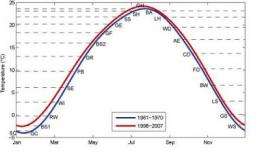Climatic warming-induced change in timings of 24 seasonal divisions in China since 1960

Changes of seasonal cycles are important to social and economic activities, agricultural planning in particular. Qian et al. quantified changes in the timings of 24 seasonal divisions conventionally known in China as the "24 Solar Terms," based on a recently developed homogenized dataset of daily temperature observations dating to 1960. The results provide quantitative guidance for adaptation to global warming in the region.
The Twenty-four Solar Terms are ancient Chinese terms used for about 2000 years. They describe 24 stages or timings associated with seasonal changes in phenology and agricultural activity throughout a year. Qian et al. from the Key Laboratory of Regional Climate-Environment for East Asia, Chinese Academy of Sciences, quantitatively defined the somewhat 'astronomic' term for the first time, based on modern temperature records. This facilitated an investigation of changes in the climatic Solar Terms under global warming over the past half-century. Their results were based on a recently developed homogenized dataset of daily temperature observations, dating to 1960. According to these results, the timings of the climatic Solar Terms during the warming phase (around spring) of the seasonal cycle have significantly advanced (by 6-15 days) from the 1960s to the present.
Across China, timings during the cooling phase (around autumn) have delayed by 5-6 days on average. This is mainly because of a warming shift of the entire seasonal temperature cycle, as illustrated in the figure. Four particular phenology-related climatic Solar Terms, namely the Waking of Insects, Pure Brightness, Grain Full, and Grain in Ear, have advanced almost everywhere in the country (as much as 20 days in North China). This has important implications for agricultural planning. The numbers of extremely cold (Great Cold) days decreased by 56.8% over the last 10 years as compared with the 1960s, whereas those of extremely hot (Great Heat) days increased by 81.4%. The paper entitled 'Climatic changes in the Twenty-four Solar Terms during 1960-2008' is published in Chinese Science Bulletin, 2012, Vol 57(2).
The present results imply that under concurrent global warming and consequent earlier / delayed timings of the climatic Twenty-four Solar Terms, planning various human activities (especially agricultural ones) based on traditional experience requires adjustment. It has been suggested that decision-making regarding climate change adaptation should take into account more climate elements, such as changes in precipitation and climate extremes, plus technological advances.
More information: Qian C, Yan Z W, Fu C B. Climatic changes in the Twenty-four Solar Terms during 1960-2008, Chinese Sci. Bull., 2012, 57(2): 276-286
Journal information: Chinese Science Bulletin
Provided by Science in China Press















